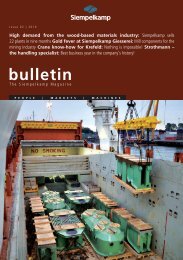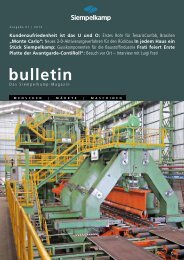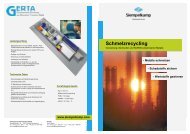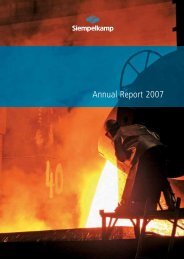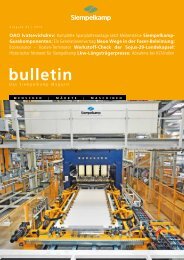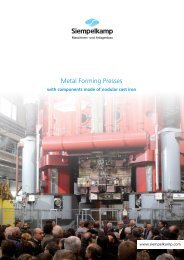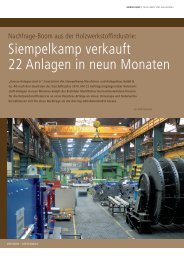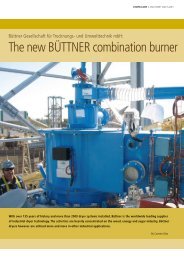Bulletin 1/2011 - Siempelkamp
Bulletin 1/2011 - Siempelkamp
Bulletin 1/2011 - Siempelkamp
You also want an ePaper? Increase the reach of your titles
YUMPU automatically turns print PDFs into web optimized ePapers that Google loves.
Interview with the<br />
managing directors<br />
Herman Vervliet,<br />
MSDG and Bernd-Dieter<br />
Wessolowski, STS<br />
How did you manage to enter the<br />
French market with such succes?<br />
Herman Vervliet: We have positioned<br />
ourselves with our expertise in a niche<br />
market. Our technical concept as well as<br />
our services fit right in. Another convincing<br />
factor: Most effective stud tensioners are<br />
the flagships of StS (see box “From<br />
mining to nuclear technology”) and therefore<br />
also of MSDG. this is how we beat<br />
the competition.<br />
What are the characteristics of a good<br />
stud tensioners?<br />
Bernd-Dieter Wessolowski: Short and to<br />
the point, the four highlights include: speed,<br />
high degree of automation, reliability and<br />
low personnel and maintenance costs.<br />
The opening of a pressure vessel is a<br />
challenge and long downtimes are to<br />
be avoided. How often is a pressure<br />
vessel opened?<br />
Bernd-Dieter Wessolowski: Most of the<br />
time a pressure vessel is opened after an<br />
interval of 12 to 18 months when the reactor<br />
core has to be tested and depend ing<br />
on the test results spent fuel elements<br />
have to be replaced or repositioned inside<br />
the reactor pressure vessel. By the way, for<br />
these tests the <strong>Siempelkamp</strong> subsidiary<br />
nIS Ingenieurgesellschaft provides the<br />
appropriate service, that is, the incore fuel<br />
management.<br />
What exactly happens during this<br />
process?<br />
Herman Vervliet: to open the reactor,<br />
first, the studs are simultaneously tensioned.<br />
these studs have an impressive size.<br />
With a length between 1,700 and 1,900<br />
mm they correspond to the body height of<br />
a person. their diameter ranges from 150<br />
to 210 mm and their weight from 300 to<br />
600 kg. to tension such large studs,<br />
hydraulic pressures of 800 to 1,000 t are<br />
applied to each stud. this process is carried<br />
out under controlled conditions which<br />
have a positive effect on the vessel cover<br />
and sealing materials. Here we achieve<br />
precision of 1/100 mm. thereafter, the<br />
studs, up to 72 depending on the reactor<br />
type, are simultaneously screwed out in<br />
sets of four. the proof of residual elongation,<br />
which we will furnish last, is crucial<br />
for the tightness of the cover.<br />
One of the core competences of STS<br />
and MSDG is service – a convincing<br />
performance which the order for the<br />
ten-year service contract confirms.<br />
Which services are covered in the<br />
contract?<br />
Herman Vervliet: During the duration of<br />
the ten-year contract, our personnel will<br />
operate the stud tensioners and is responsible<br />
for their maintenance. the decision<br />
of what kind of and when a process has to<br />
be initiated is made by StS. Furthermore,<br />
we will supply spare parts which are stored<br />
SieMpelkaMp | nUCLEAR tECHnOLOGy<br />
German-French understanding: from left to right Bernd Wessolowski, (Managing Director STS),<br />
Thomas Otto and Herman Vervliet, (Managing Directors MSDG)<br />
From mining to nuclear techno -<br />
logy: 40 years of multiple tensioning<br />
systems.<br />
In the 1960s Klöckner-Ferromatik, the<br />
predecessor of StS, developed the first<br />
hydraulic stud tensioner.the concept of<br />
the machine was based on experience<br />
gathered by our pre cursor company in<br />
the field of hydraulics for mining equip -<br />
ment. the first hydraulic stud tensioner,<br />
commissioned in 1964, was capable of<br />
simultaneously tensioning 36 reactor<br />
pressure vessel studs in the nuclear<br />
power plant Obrigheim on the neckar<br />
river, in Germany. the nuclear power<br />
plant opted for this tensioning system<br />
because special equipment complying<br />
with the highest safety standards was<br />
required for open ing and closing the<br />
reactor pressure vessel.<br />
Retaining the original product idea, more<br />
than 40 years of intensive development<br />
work and the exchange of experiences<br />
with customers led to the new generation<br />
of stud tensioners, with which the<br />
simultaneous hydraulic elongation of<br />
the reactor studs is only one of many<br />
functions. Remote con trolled and<br />
automated turning of reactor studs and<br />
cover nuts, as well as functions such as<br />
measuring, acquisitioning and registering<br />
relevant operating conditions and<br />
parameters, are integrated features<br />
today. With today’s stud tensioners it is<br />
also possible to handle and transport<br />
reactor pressure vessel studs and nuts<br />
for shortening the maintenance<br />
overhaul times!





